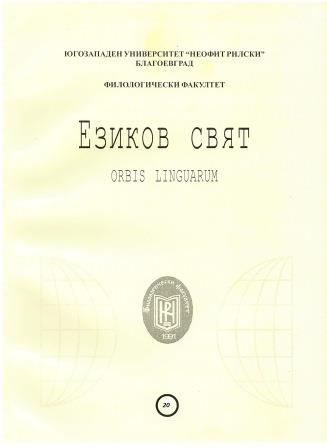РЕАЛНОСТ И УТОПИЯ В ТВОРЧЕСТВОТО НА ГЕЙЗА ВАМОШ
REALITY AND UTOPIA IN THE WORKS OF GEJZA VAMOŠ
Author(s): Dagmar Garay KrochanovaSubject(s): Language and Literature Studies, Jewish studies, Studies of Literature, Slovak Literature, Philology
Published by: ЮГОЗАПАДЕН УНИВЕРСИТЕТ »НЕОФИТ РИЛСКИ«
Keywords: Gejza Vamoš (1901 – 1956); interwar period; Slovak literature; Jewish studies
Summary/Abstract: Gejza Vamoš (1901 Devavanya, Hungary – 1956 Muriae Minas, Brazil) is one of the most remarkable Slovak writers of the interwar period. His life and literary work is similar to those of a number of European intellectuals of Jewish origin, who experienced otherness and alienation, and looked for strategies to overcome them. Despite the fact that the legislation in the Czechoslovak Republic in the interwar period supported religious equality, the stereotypes concerning the Jews and the doubts about their assimilation continued. Vamoš expressed his ideas about a new community in his doctoral dissertation in philosophy Princip krutosti (The Principle of Cruelty) defended at Comenius University in Bratislava in 1932 as well as in his literary works, especially in the novels Atomy Boha (Atoms of God) (1928) and Odlomena haluz (Broken Branch) (1934). The former work challenges the idea of creation and perceives a doctor of medicine as a new prophet, whereas the latter one discusses the possibilities of Jewish assimilation and the problems of upbringing. Odlomena haluz was awarded a prize in Prague but at the same time Vamoš faced lawsuits and severe accusations related to some parts of the novel. In 1939, he left for China, and in the late 1940s, he moved to Brazil. New editions of his fiction appeared in Czechoslovakia in the 1960s, and after 1989, his work was included in the history of philosophical thinking in Slovakia
Journal: Езиков свят - Orbis Linguarum
- Issue Year: 20/2022
- Issue No: 1
- Page Range: 121-129
- Page Count: 9
- Language: Bulgarian

